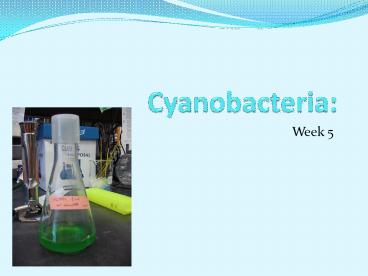Cyanobacteria: - PowerPoint PPT Presentation
Title:
Cyanobacteria:
Description:
... to reconstitute KaiC phosphorylation cycle with Biobrick'd luciferase reporter. ... Using PCR to create and extract the correct constructs. ... – PowerPoint PPT presentation
Number of Views:121
Avg rating:3.0/5.0
Title: Cyanobacteria:
1
Cyanobacteria
- Week 5
2
Project Goals
- Reconstitute the KaiC phosphorylation cycle in E.
coli.
- Create KaiA and KaiBC biobricks.
- Transform E. coli with Kai Biobricks to
reconstitute KaiC phosphorylation cycle with no
reporter attached. - Distant Transform E. coli with Kai Biobricks to
reconstitute KaiC phosphorylation cycle with
Biobrickd luciferase reporter.
3
Mechanism Review
Tomita 2005
4
(No Transcript)
5
Current Challenges
- Using PCR to create and extract the correct
constructs. - Synchronizing the Kai cycle within one E. coli
cell. - Pick inducible promoters for KaiA and KaiBC.
- Performing Western blots to detect KaiC within E.
coli.
6
Week in Review
- Grew liquid cultures and plates from the new PCC
7942. - Our PCR produced a 3kb fragment which we hope is
KaiABC (sequencing pending) . - Began crossover PCR for site-specific
mutagenesis. - Planned future experiments with E. coli.
- Decided to eliminate the branch of our project
dealing with cyanobacteria. - Designed primers for sequencing KaiABC and
extracting coding sequence.
7
KaiABC extraction
- Lane 21 3kb segment
- Lane 16, 20, 24 Positive Control
- Other lanes experimental (failed)
8
Failed site-specific mutagenesis PCR
- Lanes 1-3 2402 bp expected
- Lanes 4-6 209 bp expected
- Lanes 7-8 80 bp expected
- Lanes 9-10 370 bp expected
- Lanes 11-13 370 bp expected
9
Experiment 1
- Goal
- Verify that our KaiA and KaiBC Biobricks can be
expressed in E. coli. - Procedure
- Tag KaiA/BC (e.g. with a fluorescent subunit).
- Insert the tagged KaiA/BC into E. coli.
- Induce promoters for both KaiA and KaiBC.
- Measure the E. coli fluorescence.
- We should see some fluorescence, indicating that
our promoters are working and the Kai genes are
being expressed.
KaiA
KaiBC
1.
10
Experiment 2
- Goal
- Verify that KaiA, KaiB and KaiC are interacting
and phosphorylating KaiC in E. coli. - Procedure
- Insert KaiA and KaiBC into E. coli.
- Induce KaiBCs promoter and measure the amount of
phosphorylated KaiC via Western blot. - Induce KaiAs promoter and measure the amount of
phosphorylated KaiC via Western blot. - Ideally, we would see an increase in the amount
of phosphorylated KaiC between steps 2 and 3.
This would indicate that the Kai proteins are
interacting as they do in vivo. However, some
care needs to be taken in deciding when exactly
to measure the phosphorylated KaiC, to determine
when/if KaiC is phosphorylated in the absence of
KaiA. In that case, we may not see as much of a
difference between steps 2 and 3.
KaiA
KaiBC
1.
2.
11
Experiment 3
- Goal
- To measure the oscillation of the KaiC
phosphorylation cycle given pulsed KaiA and KaiBC
production. - Procedure
- Insert KaiA and KaiBC into E. coli.
- Induce the promoter for KaiA and KaiBC at the
same time. - After a short time, turn off the promoters.
- Measure the amount of phosphorylated KaiC at
regular intervals (e.g. every hour) via Western
blot. - We hope to initially see strong oscillation, with
the amplitude decreasing over time. Since no
KaiA/B/C should be produced after the initial
pulse, we expect that the intracellular
concentrations of the Kai proteins would decrease
as the E. coli divide.
KaiA
KaiBC
1.
12
Experiment 4
- Goal
- To measure the oscillation of the KaiC
phosphorylation cycle given constant KaiA and
pulsed KaiBC production. - Procedure
- Insert KaiA and KaiBC into E. coli.
- Induce the promoters for KaiA and KaiBC.
- After a short time, turn off the KaiBC promoter,
leaving the KaiA promoter induced. - Measure the amount of phosphorylated KaiC at
regular intervals. - We expect that, since KaiA is produced at a
constant (non-oscillating) rate in cyanobacteria,
its constant production in E. coli should not
interfere with KaiCs phosphorylation cycle. The
constant production of KaiA may even strengthen
the oscillation, since KaiA wont degrade or
dilute away.
KaiA
KaiBC
1.
13
Experiment 5
- Goal
- To measure the oscillation of the KaiC
phosphorylation cycle, given constant KaiA and
KaiBC production. - Procedure
- Insert KaiA and KaiBC into E. coli.
- Induce the promoters for KaiA and KaiBC.
- Measure the amount of phosphorylated KaiC at
regular intervals. - We do not know how constant KaiBC transcription
will interfere with the oscillation of KaiC (in
cyanobacteria, KaiBC transcription oscillates on
a circadian rhythm). This experiment should help
us figure it out.
KaiA
KaiBC
1.
14
To Do
- Sequence our 3kb construct.
- Extract KaiA and KaiBC coding sequences from
KaiABC region. - Select inducible promoters for experiments.
- Create experiment constructs.
- Learn Western blot protocol.
- Perform experiments and measure results.
- Design new experiments as the need arises.































